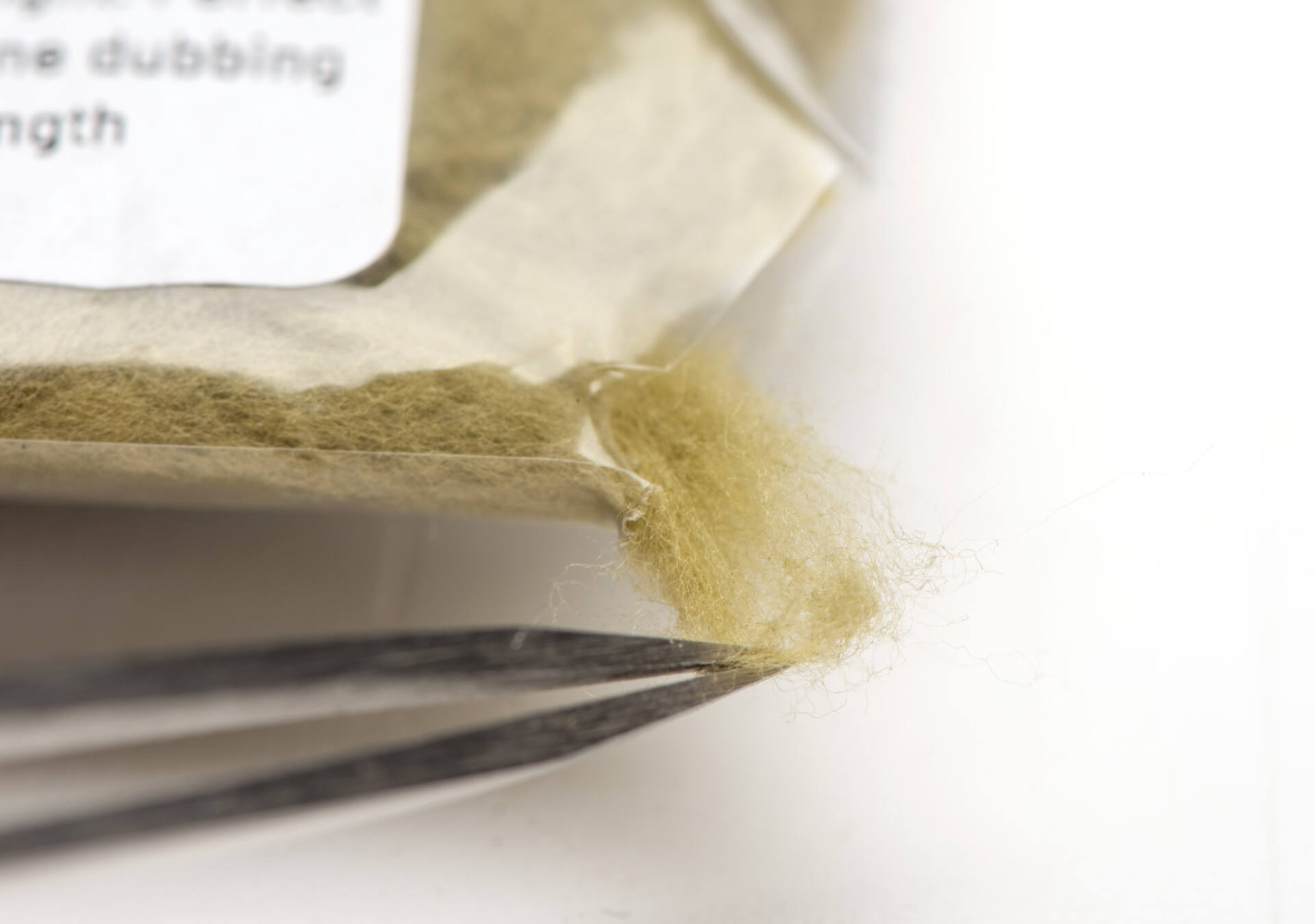Fine, natural, allergy-free dry fly dubbing

Kapok dispenser, packed with dubbing.
Interesting stuff, kapok trees are originally from Central and South American rainforests, now planted in West Africa and south-east Asia, kapok fibre comes from the seed pods. Historically, kapok has been used for stuffing, in life-jackets, thermal and acoustic insulation, toys and pillows. Kapok fibre is extremely fine, relatively short, and not very strong. The fibres are hollow, glossy with a water-repelling wax surface – cited as “…the lightest natural fibres… eight times lighter than cotton.” We are talking about a yellowish fibre that looks like cotton, but with a silk-like sheen. As an aside, Kapok does not cause allergies – one of the reasons it was used for stuffed toys and expensive pillows.

Kapok is fine, soft, very light indeed.
Kapok has not traditionally lent itself to more extensive processing, eg, yarn or thread-making, the fibres being too short and fragile for spinning and like cotton, and kapok is not the easiest stuff to dye. Modern textile research into organic/renewable fibres has led to new ways of dyeing, processing and using cellulosic fibres – including kapok – which I think is where this dubbing material comes from, nicely dyed, beautifully combed or carded.
Short staple
I have a selection dispenser and a few packets of Kapok Dubbing by Semperfli. Looks like the dyeing issue has been solved, some colours here I doubt I’ll use on dry flies and others which are just right. The packets show the real quality of this stuff, the fibre in the dispenser is tight packed and needs teasing and fluffing out, from a packet I can just pull a pinch. The fibre is very glossy and fine, I’d guess the staple length is around one centimetre, short compared to most dubbing. The fibres cling to one another, which can be good for dubbing, and I can tease out the finest wisp of material – which floats off at the slightest excuse.
Used as a conventional dubbing, tease out a slim, even mat of fibre, roll and twist it around the tying thread to form a slim ‘noodle’. I get slight clumps which need to be spread. Twisted tight, this dubbing tends to stay rolled, it’s not so easy to go back and thin the dubbing and start again. On thread this can form an exceptionally slim dubbed strand, which is easy to wrap onto a hook.
Easy
I was aiming to get enough dubbing spread on my thread to cover the thread, then wrap a single layer along a hook – I think that worked well. Come the point where I want to clean excess dubbing off my thread, short fibres which break away makes that easy. Comparing this with Superfine (long, strong, slippery poly fibres) my usual dubbing for fine dry flies, Kapok can be easier to work with.
For a split thread or a fine dubbing loop, prepare a fine wisp of dubbing, flatten and split the tying thread, place the dubbing between the thread strands and twist them up. I can get a couple of effects.
Sparse
Applied extremely sparsely, as evenly as possible, almost ‘touch dubbing’ one strand of the thread, avoid handling the dubbing once on the thread, twist up and wrap. The effect can be like dubbing with mole, just a sparse mist of fine fibres around coloured thread. Looks great!
Dub slightly more generously, twist the thread to trap and cord the fibre, effectively make a chenille. I found I had to pick some dubbing off the twisted rope to make it more even. I have the option of rolling the dubbed thread between my fingers to make the dubbed portion of thread less fluffy, which is what I prefer for dry fly bodies.
Mixing
Kapok dubbing is not the easiest stuff to mix, but a couple of small wisps can be coaxed together. Knots and tangles need to be picked out and discarded. When a wrap of dubbing was tightened then pulled off of thread I could rarely re-use it – far easier to discard and take some fresh.
At my vice, dubbing wax didn’t seem to work well with Kapok, bare thread worked fine, soft sticky wax made a bit of a gooey mess with the fine fibres.
Slim, and small
I found myself tying on smaller hooks and or making slimmer flies, the way this handles lends itself to tying carefully tapered flies. For my own tying I have been using Kapok on some size 14s and smaller hooks, at the same time using finer threads. I’m sure it could be used on bulkier flies.
I think of this as a dry fly dubbing: fine fibre, buoyant and naturally water repellent, so I’m not sure when I’ll use bright, fluorescent colours. I want natural, delicate subtle shades: creams, tans, olives; this selection offers a few, maybe I can mix more.
I like how Kapok dubbing looks on a fly and I like working with it.
Price: Filled dispenser (12 colours) £34.00. Single colour packets £2.99 each.
From: Semperfli stockists.

Mixed kapok dubbing in a split thread. Dubbed a little heavier, twisted so it corded on the thread.

Packets let the dubbing open up, not as scrunched tight.

Size 18 spider hook. Using a fine thread and the merest wisp of dubbing.

Light olive kapok, twisted onto the thread, ribbed with tying thread, a touch of squirrel at the head. Kapok makes a fine dubbing strand which makes a carefully tapered body that bit easier.

Kapok mixes surprisingly well, pale olive and Adams make a very buggy brown/olive.

Dubbed as lightly as possible. The under-body forms the shape. Kapok dubbing was applied as lightly as possible in split thread so the black thread shows through.



